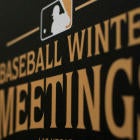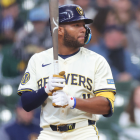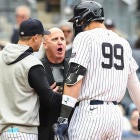When all 30 teams, agents big and small, swaths of media, and various and sundry onlookers caucus each December for the winter meetings, we expect big things to happen. To wit, we expect free-agent dollars to fly, and we expect blockbuster trades to be forged in a GM's hotel suite or perhaps in the lobby within hailing distance of a bartender.
Very often, that does happen. At the 2014 winter meetings, the Cubs landed Jon Lester in an agreement that would help alter the course of franchise history. In 2011, the Angels paid enough to get Albert Pujols out of St. Louis. In 2008, CC Sabathia became a Yankee. At the 2000 winter meetings, the Red Sox lured Manny Ramirez to Boston, while the Rangers inked Alex Rodriguez for a then-unthinkable sum. Two winter meetings prior, Kevin Brown became MLB's first $100 million player. That's to say nothing of the legendary trades that have gone down at places like Nashville and Dallas while the holidays barreled toward us.
The 2018 model, however, bestowed nothing quite so epic. In the days and weeks leading up to the three-days-and-change jam session in Vegas, we saw swaps involving the likes of James Paxton, Robinson Cano, Jean Segura and Paul Goldschmidt. In the days and weeks to follow, Bryce Harper and Manny Machado may sign the biggest contracts in the annals of the game. The winter meetings itself, though, played host mostly to some mid-level contract agreements and some trades that were more interesting than breathtaking.
For instance, here the finalized transactions that took place in Vegas:
MONDAY, DEC. 10
- Baltimore Orioles – Claimed RHP Rio Ruiz off waivers from the Atlanta Braves.
- Boston Red Sox – Signed free agent RHP Nathan Eovaldi.
- Cincinnati Reds – Claimed LHP Robby Scott off waivers from the Boston Red Sox.
- Detroit Tigers – Signed free agent RHP Tyson Ross.
- San Diego Padres – Signed free agent RHP Garrett Richards.
- San Francisco Giants – Claimed OF Michael Gerber off waivers from the Detroit Tigers.
- Seattle Mariners – Claimed INF Kaleb Cowart off waivers from the Los Angeles Angels.
- St. Louis Cardinals – Claimed RHP Ryan Meisinger off waivers from the Baltimore Orioles.
- Texas Rangers – Claimed INF Carlos Asuaje off waivers from the San Diego Padres.
TUESDAY, DEC. 11
- Chicago White Sox – Acquired RHP Ivan Nova from the Pittsburgh Pirates for RHP Yordi Rosario.
- Kansas City Royals – Signed free agent OF Billy Hamilton.
- Oakland Athletics – Signed free agent C Chris Herrmann.
- St. Louis Cardinals – Acquired INF Drew Robinson from the Texas Rangers for INF Patrick Wisdom.
- Toronto Blue Jays – Released INF Troy Tulowitzki.
WEDNESDAY, DEC. 12
- Cincinnati Reds – Acquired RHP Tanner Roark from the Washington Nationals for RHP Tanner Rainey.
- Philadelphia Phillies – Signed free agent OF Andrew McCutchen.
That's not counting Thursday's Rule 5 Draft, and that's not counting reported transactions yet to be announced like the Yankees and J.A. Happ, the Rays and Charlie Morton and the three-way trade that landed Carlos Santana back in Cleveland.
Like we said, more interesting than breathtaking.
Given all that, one can be forgiven for thinking the winter meetings have outlived their usefulness.
Yes, there's something to be said for the social aspect of it, and the event occasions a lot more than "just" live and in-person dealmaking. There's the announcement of the Era Committee Hall of Fame ballot, a trade show, a job fair, manager media availability, the aforementioned Rule 5 Draft and assorted miscellany. The real draw of the winter meetings, though -- the thrill of the deal -- has become something of an unreliable presence.
This is to be expected. Front office decision-makers are skewing younger and younger these days, and in the era of instant communication the liturgies of in-person horse trading matter less to them. That's not necessarily a bad or good thing, but it is a thing. If anything, it's a comment upon the rigidity of the winter meetings.
Also, one could argue that the somewhat homogeneous way in which front offices have come to value on-field talent means there's less to hash out. There's a foundation of similar understanding going in, and trades and signings can spring to life via a handful of text messages or even relic phone calls.
Consider what Braves GM Alex Anthopoulos recently told David O'Brien of The Athletic:
"I just think the Winter Meetings aren't the best environment to work in. You're in a hotel suite; you have everything you normally work with (back) in the office. You're still active; you're still engaged. But in the past if we were close on something, I try to push, get it across into the end zone just before the meetings. Otherwise, I don't think I've been very active at the meetings in the past, and a lot of times you come out of the meetings you feel like you're getting close, and you try to finalize something maybe a week or two after the fact."
Maybe the new normal for the winter meetings is building toward something. Of course, that's something that could've taken place outside of what's in essence a convention. After all, plenty of deals happen leading up to the July 31 non-waiver deadline with the seeming benefit of face-to-face negotiation.
To be sure, the winter meetings are still engaging, in that it's good for a steady supply of tantalizing rumors, and those always have appeal. As for actual activity, teams and players are going to strike agreements when they feel the time, the market, and the offer is right. Our own Matt Snyder just reported on an informal groundswell of support for a winter trade deadline that would certainly inject some life into the winter meetings. That, however, would be a pretty major structural change, and it might serve to bump baseball from the news cycle for what's left of the winter.
Or, maybe, there's this:
One prominent agent on the #MLB winter meetings: “It’s just an excuse for everybody to get out of the house.”
— Jerry Crasnick (@jcrasnick) December 13, 2018
If that plus the rumor indulgences are enough to justify the get-together, then let's proceed as usual. If, however, we want the winter meetings to be the locus of offseason activity, which it once was, then something needs to change.






















